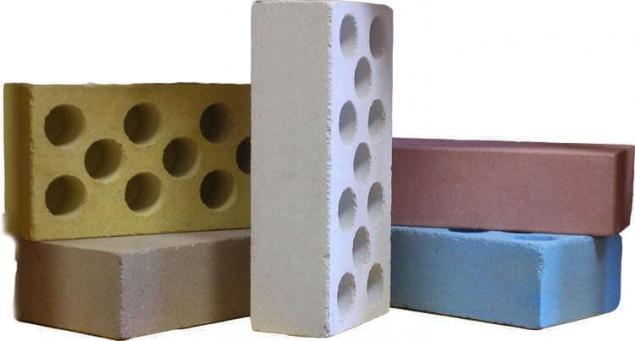720
The white house: the good sand-lime brick
It is clear that the differences between the red brick (relatively speaking, of burnt clay) and white (white sand) is very strong. In addition to sand, the raw material consists of lime and water, which are mixed with each other in certain proportions. Next, this mixture is subjected to steaming under pressure (lime and sand mixed in the proportion of 1:9), and then the molded bricks are fired in an autoclave, then dried and the bricks ready. There is another method that uses hydrated lime, but does not apply pairs.
Technology was originally developed in Germany, but in Russia (especially the USSR) has been widely applied, and this process began before the revolution. It is believed that the massive success of the Silex brick production in the USSR is linked with the fact that the environmental harm (to clarify: not the brick, and its mass production!) in a planned economy, nobody paid special attention.
Today calcium silicate bricks produce more than hundreds of enterprises in Russia, although it is obvious that the "white brick" on construction sites fairly pushed aerated concrete and foam concrete blocks. This is due to the relative cheapness of the latter, although the difference in their properties (and quality) compared to the silicate brick are sometimes very high.

Anyway, we still produced niskolechko standard sizes of silica brick: 250 x 120 x 65 mm 250 x 88 x 54 mm. ("VMC"), and 250 x 120 x 88 mm (thickened). Brick can be full or hollow. In the brick holes are arranged vertically and are usually made blind (unlike red, ceramic).
It is clear that the brick "voids" more lightweight (under 4 lbs.) and reduces the load on the Foundation; it teplosernaya properties is similar in principle to the properties of a full-bodied, at least, the differences are not so significant as in the case of red brick. By the way, frost typicalagerange by the manufacturer (respectively, from smaller to larger — F15, F25, F35, F50). At the same time for the front (facade) wall used the last two options — F35 and the F50.
The density of brick can range from 1300 to 1900 g/CC, which provides very good strength characteristics in compression. This allows the use of silicate bricks for construction of multi-storey buildings with bearing walls. For example, brick brands M100 (international classification) can be used in the construction of low houses (2-3 floors), but in buildings with a greater height is required the bricks greater strength: M150, M200 and above.
However, sand-lime brick is sensitive to moisture. It is obvious, if we recall its chemical formula. However, at the same time, the finished brick does not contain any special hazardous substances — moreover, slaked lime is a natural septic tank: you will not see on the walls of fungus or mold. As for the tendency to moisture absorption, this lack is mitigated by adding in the composition of different hydrophobic impregnation.
Interestingly, the same disadvantage turns into an advantage: the laying of a silicate brick is not so much transmitting sound, as a clutch of red — on the contrary, the sound of the walls "fades out", which is very good for residential premises.

Incidentally, the water absorption of silica brick according to GOST 379-95 modern "Bricks and stones silicate. Technical conditions" shall not be less than 6%. Interestingly, ceramic brick, it can reach 13%. The rate of absorption of water from a silicate brick is even lower than the ceramic (which is important, for example, if open storage)!
Slag and ash bricks - modern variety of the silica brick. Obviously what you are doing with the addition of blast furnace slag, with the addition of ash. They are usually cheaper and have a lower density, but the height of the building, entirely built of this brick, should be limited.
Also produces sand-lime blocks, or "silica stone" (length varies from 225 to 512 mm; height 88-248 mm; and the thickness 44-188 mm). They are almost always hollow, weighing up to 21 kg. of Silicate blocks can be produced smooth or with topography (e.g., elevation).
These units are well suited, for example, for layout of interior walls (along with the traditional concrete blocks), and from the point of view of noise reduction, their use is even more preferable.
Limiting the application of silica brick are also obvious and are derived from its properties. Such bricks should not be used for calculations of ground floors and basements — not so much because of moisture absorption, but because of the possible impact of aggressive salts contained in the groundwater. Also it should not be used in buildings and premises, which provides a high level of moisture (baths, pools); limited to its application in high temperatures or with sudden temperature drops (no one ever makes the oven of silica bricks!) In General, the maximum use temperature of silica brick should not exceed 550 °C. And for calculations of load-bearing walls, this material fits perfectly.
In the case of combination of masonry (from the "white" and "red" bricks) or when facing masonry decorative ceramic brick, it should be borne in mind the different coefficients of thermal expansion of both materials. Better not to mix one with the other, and between the main and decorative stonework to leave a technology gap (to avoid cracks).
Among the new trends in the construction market — the emergence of colored silica brick. And it is painted not on the surface and in the mass, and thus almost does not lose its original color. Its use in, say, the masonry of the facade can be a very interesting aesthetic decision. published
P. S. And remember, only by changing their consumption — together we change the world! ©
Join us in Facebook , Vkontakte, Odnoklassniki
Source: estp-blog.ru/rubrics/rid-24909/
Technology was originally developed in Germany, but in Russia (especially the USSR) has been widely applied, and this process began before the revolution. It is believed that the massive success of the Silex brick production in the USSR is linked with the fact that the environmental harm (to clarify: not the brick, and its mass production!) in a planned economy, nobody paid special attention.
Today calcium silicate bricks produce more than hundreds of enterprises in Russia, although it is obvious that the "white brick" on construction sites fairly pushed aerated concrete and foam concrete blocks. This is due to the relative cheapness of the latter, although the difference in their properties (and quality) compared to the silicate brick are sometimes very high.

Anyway, we still produced niskolechko standard sizes of silica brick: 250 x 120 x 65 mm 250 x 88 x 54 mm. ("VMC"), and 250 x 120 x 88 mm (thickened). Brick can be full or hollow. In the brick holes are arranged vertically and are usually made blind (unlike red, ceramic).
It is clear that the brick "voids" more lightweight (under 4 lbs.) and reduces the load on the Foundation; it teplosernaya properties is similar in principle to the properties of a full-bodied, at least, the differences are not so significant as in the case of red brick. By the way, frost typicalagerange by the manufacturer (respectively, from smaller to larger — F15, F25, F35, F50). At the same time for the front (facade) wall used the last two options — F35 and the F50.
The density of brick can range from 1300 to 1900 g/CC, which provides very good strength characteristics in compression. This allows the use of silicate bricks for construction of multi-storey buildings with bearing walls. For example, brick brands M100 (international classification) can be used in the construction of low houses (2-3 floors), but in buildings with a greater height is required the bricks greater strength: M150, M200 and above.
However, sand-lime brick is sensitive to moisture. It is obvious, if we recall its chemical formula. However, at the same time, the finished brick does not contain any special hazardous substances — moreover, slaked lime is a natural septic tank: you will not see on the walls of fungus or mold. As for the tendency to moisture absorption, this lack is mitigated by adding in the composition of different hydrophobic impregnation.
Interestingly, the same disadvantage turns into an advantage: the laying of a silicate brick is not so much transmitting sound, as a clutch of red — on the contrary, the sound of the walls "fades out", which is very good for residential premises.

Incidentally, the water absorption of silica brick according to GOST 379-95 modern "Bricks and stones silicate. Technical conditions" shall not be less than 6%. Interestingly, ceramic brick, it can reach 13%. The rate of absorption of water from a silicate brick is even lower than the ceramic (which is important, for example, if open storage)!
Slag and ash bricks - modern variety of the silica brick. Obviously what you are doing with the addition of blast furnace slag, with the addition of ash. They are usually cheaper and have a lower density, but the height of the building, entirely built of this brick, should be limited.
Also produces sand-lime blocks, or "silica stone" (length varies from 225 to 512 mm; height 88-248 mm; and the thickness 44-188 mm). They are almost always hollow, weighing up to 21 kg. of Silicate blocks can be produced smooth or with topography (e.g., elevation).
These units are well suited, for example, for layout of interior walls (along with the traditional concrete blocks), and from the point of view of noise reduction, their use is even more preferable.
Limiting the application of silica brick are also obvious and are derived from its properties. Such bricks should not be used for calculations of ground floors and basements — not so much because of moisture absorption, but because of the possible impact of aggressive salts contained in the groundwater. Also it should not be used in buildings and premises, which provides a high level of moisture (baths, pools); limited to its application in high temperatures or with sudden temperature drops (no one ever makes the oven of silica bricks!) In General, the maximum use temperature of silica brick should not exceed 550 °C. And for calculations of load-bearing walls, this material fits perfectly.
In the case of combination of masonry (from the "white" and "red" bricks) or when facing masonry decorative ceramic brick, it should be borne in mind the different coefficients of thermal expansion of both materials. Better not to mix one with the other, and between the main and decorative stonework to leave a technology gap (to avoid cracks).
Among the new trends in the construction market — the emergence of colored silica brick. And it is painted not on the surface and in the mass, and thus almost does not lose its original color. Its use in, say, the masonry of the facade can be a very interesting aesthetic decision. published
P. S. And remember, only by changing their consumption — together we change the world! ©
Join us in Facebook , Vkontakte, Odnoklassniki
Source: estp-blog.ru/rubrics/rid-24909/






















